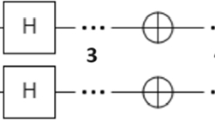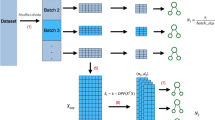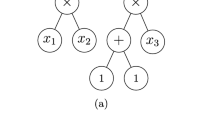Abstract
Quantum computing (QC) has the potential to strongly impact various sectors like finance, healthcare, communication, and technology by driving innovation across optimization and machine learning. Applications of QC in chemical, pharmaceutical, and biomolecular industries are also predicted to grow rapidly in the near future. Advancements in quantum hardware and algorithms have helped accelerate the widespread adoption of QC. Yet, despite the progress, several research gaps and challenges need to be addressed before leveraging QC for chemical engineering applications. Quantum computers offer higher computational power due to the exploitation of their quantum mechanical properties. However, not all computationally intractable problems can benefit from QC’s computational abilities. Achieving speedups over classical computing with quantum algorithms implemented on current quantum devices is possible for a few specific tasks. It is imperative to identify chemical engineering problems of practical relevance that may benefit from novel quantum techniques either with current quantum computers or of the future. Here, we present an introduction to basic concepts of QC while identifying the limitations of current quantum computers. A review of quantum algorithms that may benefit optimization and machine learning in chemical engineering with current quantum computers is also provided. This work also sets expectations for quantum devices of the future by exploring similar applications that may benefit from quantum algorithms implemented on such devices.
Similar content being viewed by others
References
M. A. Nielsen and I. Chuang, Quantum computation and quantum information, American Association of Physics Teachers (2002).
N. Friis, O. Marty, C. Maier, C. Hempel, M. Holzäpfel, P. Jurcevic, M. B. Plenio, M. Huber, C. Roos, R. Blatt and B. Lanyon, Phys. Rev. X, 8, 021012 (2018).
F. Arute, K. Arya, R. Babbush, D. Bacon, J. C. Bardin, R. Barends, R. Biswas, S. Boixo, F. G. Brandao and D. A. Buell, Nature, 574, 505 (2019).
A. Montanaro, npj Quantum Inf., 2, 15023 (2016).
S. Imre and F. Balazs, Quantum computing and communications: an engineering approach, John Wiley & Sons (2005).
R. Orús, S. Mugel and E. Lizaso, Rev. Phys., 4, 100028 (2019).
M. Ying, Artif. Intell., 174, 162 (2010).
R. P. Feynman, Simulating physics with computers, CRC Press (2018).
P. Benioff, J. Stat. Phys., 22, 563 (1980).
S. Gamble, in Frontiers of engineering: Reports on leading-edge engineering from the 2018 symposium, National Academies Press (2019).
R. Raz and A. Tal, in Proceedings of the 51st Annual ACM SIGACT Symposium on Theory of Computing (2019).
M. Fingerhuth, T. Babej and P. Wittek, PloS One, 13, 0208561 (2018).
G. Garnier, Front. Chem., 2, 17 (2014).
L. T. Biegler, I. E. Grossmann and A. W. Westerberg, Systematic methods for chemical process design, Prentice Hall, Old Tappan, NJ (1997).
S. Dutta, Optimization in chemical engineering, Cambridge University Press (2016).
V. Venkatasubramanian, AIChE J, 65, 466 (2019).
C. Shang and F. You, Engineering, 5, 1010 (2019).
J. Preskill, Quantum, 2, 79 (2018).
S. McArdle, S. Endo, A. Aspuru-Guzik, S. C. Benjamin and X. Yuan, Rev. Mod. Phys., 92, 015003 (2020).
T. T. Tran, M. Do, E. G. Rieffel, J. Frank, Z. Wang, B. O’Gorman, D. Venturelli and J. C. Beck, in Ninth annual symposium on combinatorial search (2016).
S. Harwood, C. Gambella, D. Trenev, A. Simonetto, D. Bernal and D. Greenberg, IEEE Trans. Quantum Eng., 2, 1 (2021).
A. Ajagekar, T. Humble and F. You, Comput. Chem. Eng., 132, 106630 (2020).
B. Omer, Master’s thesis, Institute of Information Systems Technical University of Vienn na (2000).
K. A. Britt and T. S. Humble, ACM J. Emerging Technol. Comput. Syst., 13, 1 (2017).
D. E. Deutsch, Proceedings of the Royal Society of London. A. Mathematical and Physical Sciences, 425, 73 (1989).
A. Adedoyin, J. Ambrosiano, P. Anisimov, A. Bärtschi, W. Casper, G. Chennupati, C. Coffrin, H. Djidjev, D. Gunter and S. Karra, arXiv preprint arXiv:1804.03719 (2018).
C. C. McGeoch, Synthesis Lectures on Quantum Computing, 5, 1 (2014).
D. J. Griffiths and D. F. Schroeter, Introduction to quantum mechanics, Cambridge University Press (2018).
T. Albash and D. A. Lidar, Rev. Mod. Phys., 90, 015002 (2018).
E. Farhi, J. Goldstone, S. Gutmann and M. Sipser, arXiv preprint quant-ph/0001106 (2000).
D. Aharonov, W. Van Dam, J. Kempe, Z. Landau, S. Lloyd and O. Regev, SIAM Rev., 50, 755 (2008).
T. Kadowaki and H. Nishimori, Phys. Rev. E, 58, 5355 (1998).
“Final Report: Emerging Technologies Subcommittee Quantum Information Science”, Homeland Security Advisory Council.
D. M. Bacon, Decoherence, control, and symmetry in quantum computers, University of California, Berkeley (2001).
Y. Xu, J. Chu, J. Yuan, J. Qiu, Y. Zhou, L. Zhang, X. Tan, Y. Yu, S. Liu and J. Li, Phys. Rev. Lett., 125, 240503 (2020).
A. Pearson, A. Mishra, I. Hen and D. A. Lidar, npj Quantum Inf., 5, 1 (2019).
D. Gottesman, arXiv preprint arXiv:0904.2557 (2009).
K. L. Pudenz, T. Albash and D. A. Lidar, Nat. Commun., 5, 3243 (2014).
A. W. Cross, L. S. Bishop, S. Sheldon, P. D. Nation and J. M. Gambetta, Phys. Rev. A, 100, 032328 (2019).
D. Gottesman, Phys. Rev. A, 57, 127 (1998).
S. Boixo, S. V. Isakov, V. N. Smelyanskiy, R. Babbush, N. Ding, Z. Jiang, M. J. Bremner, J. M. Martinis and H. Neven, Nat. Phys., 14, 595 (2018).
L. T. Biegler and I. E. Grossmann, Comput. Chem. Eng., 28, 1169 (2004).
J. A. Kelner and D. A. Spielman, in Proceedings of the thirty-eighth annual ACM symposium on Theory of computing (2006).
I. E. Grossmann and A. W. Westerberg, AIChE J., 46, 1700 (2000).
K. C. Furman and N. V. Sahinidis, Comput. Chem. Eng., 25, 1371 (2001).
I. E. Grossmann and L. T. Biegler, Comput. Chem. Eng., 28, 1193 (2004).
E. Bernstein and U. Vazirani, SIAM J. Comput., 26, 1411 (1997).
S. S. Rao, Engineering optimization: Theory and practice, John Wiley & Sons (2019).
S. Aaronson, SIGACT News, 36, 30 (2005).
R. G. Parr, Density functional theory of atoms and molecules, in Horizons of quantum chemistry, Springer (1980).
T. Helgaker, W. Klopper and D. P. Tew, Mol. Phys., 106, 2107 (2008).
Y. Cao, J. Romero, J. P. Olson, M. Degroote, P. D. Johnson, M. Kieferová, I. D. Kivlichan, T. Menke, B. Peropadre and N. P. Sawaya, Chem. Rev., 119, 10856 (2019).
A. Peruzzo, J. McClean, P. Shadbolt, M.-H. Yung, X.-Q. Zhou, P. J. Love, A. Aspuru-Guzik and J. L. O’brien, Nat. Commun., 5, 1 (2014).
B. Bauer, S. Bravyi, M. Motta and G. K.-L. Chan, Chem. Rev, 120, 12685 (2020).
M. P. Andersson, M. N. Jones, K. V. Mikkelsen, F. You and S. S. Mansouri, Curr. Opin. Chem. Eng, 36, 100754 (2022).
B. Alidaee, G. A. Kochenberger and A. Ahmadian, Int. J. Syst. Sci., 25, 401 (1994).
J. Krarup and P. M. Pruzan, Computer-aided layout design, in Mathematical programming in use, Springer (1978).
G. Kochenberger, J.-K. Hao, F. Glover, M. Lewis, Z. Lü, H. Wang and Y. Wang, J. Comb. Optim., 28, 58 (2014).
A. Ajagekar and F. You, Energy, 179, 76 (2019).
A. Lucas, Front. Phys., 2, 5 (2014).
E. Farhi, J. Goldstone and S. Gutmann, arXiv preprint arXiv:1411. 4028 (2014).
G. G. Guerreschi and A. Y. Matsuura, Sci. Rep., 9, 1 (2019).
R. Patton, C. Schuman and T. Potok, Quantum Inf. Process, 18, (2019).
J. Li and R. R. Rhinehart, Comput. Chem. Eng., 22, 427 (1998).
J. H. Lee, J. Shin and M. J. Realff, Comput. Chem. Eng., 114, 111 (2018).
J. Biamonte, P. Wittek, N. Pancotti, P. Rebentrost, N. Wiebe and S. Lloyd, Nature, 549, 195 (2017).
E. Aïmeur, G. Brassard and S. Gambs, Machine learning in a quantum world. In conference of the canadian society for computational studies of intelligence, Springer, Berlin, Heidelberg (2006).
E. Farhi and H. Neven, arXiv preprint arXiv:1802.06002 (2018).
N. Wiebe, A. Kapoor and K. Svore, arXiv preprint arXiv:1401.2142 (2014).
M. Schuld, R. Sweke and J. J. Meyer, Phys. Rev. A, 103, 032430 (2021).
L. Chiang, B. Lu and I. Castillo, Annu. Rev. Chem. Biomol. Eng., 8, 63 (2017).
I. Cong, S. Choi and M. D. Lukin, Nat. Phys., 15, 1273 (2019).
A. Ajagekar and F. You, Comput. Chem. Eng., 143, 107119 (2020).
A. W. Harrow, A. Hassidim and S. Lloyd, Phys. Rev. Lett., 103, 150502 (2009).
M. Schuld, I. Sinayskiy and F. Petruccione, Phys. Rev. A, 94, 022342 (2016).
Y. Liu and S. Zhang, Theor. Comput. Sci., 657, 38 (2017).
S. Aaronson, Nat. Phys., 11, 291 (2015).
C. Bravo-Prieto, R. LaRose, M. Cerezo, Y. Subasi, L. Cincio and P. Coles, Bull. Am. Phys. Soc., 65 (2020).
C. C. Chang, A. Gambhir, T. S. Humble and S. Sota, Sci. Rep., 9, 1 (2019).
R. Y. Li, R. Di Felice, R. Rohs and D. A. Lidar, npj Quantum Inf., 4, 14 (2018).
S. Lloyd and C. Weedbrook, Phys. Rev. Lett., 121, 040502 (2018).
M. H. Amin, E. Andriyash, J. Rolfe, B. Kulchytskyy and R. Melko, Phys. Rev. X, 8, 015002 (2018).
C. Zoufal, A. Lucchi and S. Woerner, Quantum Mach. Intell., 3, 7 (2021).
A. Ajagekar and F. You, Appl. Energy, 303, 117628 (2021).
S.Y.-C. Chen, C.-H. H. Yang, J. Qi, P.-Y. Chen, X. Ma and H.-S. Goan, IEEE Access, 8, 141007 (2020).
J. Preskill, Fault-tolerant quantum computation, in Introduction to quantum computation and information, World Scientific (1998).
E. T. Campbell, B. M. Terhal and C. Vuillot, Nature, 549, 172 (2017).
F. Arute, K. Arya, R. Babbush, D. Bacon, J. C. Bardin, R. Barends, S. Boixo, M. Broughton, B. B. Buckley and D. A. Buell, Science, 369, 1084 (2020).
L. Zhou, S.-T. Wang, S. Choi, H. Pichler and M. D. Lukin, Phys. Rev. X, 10, 021067 (2020).
F. G. Brandao and K. M. Svore, in Annual Symposium on Foundations of Computer Science (FOCS), IEEE (2017).
J. van Apeldoorn and A. Gilyén, arXiv preprint arXiv:1804.05058 (2018).
L. K. Grover, in Proceedings of the twenty-eighth annual ACM symposium on Theory of Computing, Association for Computing Machinery, Philadelphia, Pennsylvania, USA (1996).
S. Lloyd, M. Mohseni and P. Rebentrost, arXiv preprint arXiv: 1307.0411 (2013).
N. Wiebe, D. Braun and S. Lloyd, Phys. Rev. Lett., 109, 050505 (2012).
P. Rebentrost, M. Mohseni and S. Lloyd, Phys. Rev. Lett., 113, 130503 (2014).
Z. Zhao, J. K. Fitzsimons and J. F. Fitzsimons, Phys. Rev. A, 99, 052331 (2019).
S. Lloyd, M. Mohseni and P. Rebentrost, Nat. Phys., 10, 631 (2014).
D. Dong, C. Chen, H. Li and T. Tarn, IEEE Trans. Syst. Man Cybern. Part B Cybern., 38, 1207 (2008).
Author information
Authors and Affiliations
Corresponding author
Additional information
Professor Fengqi You is currently Roxanne E. and Michael J. Zak Professor in Cornell University, Ithaca, New Yok, USA. He also serves as Chair of PhD Studies in Cornell Systems Engineering, Associate Director of Cornell Energy Systems Institute, and Associate Director of Cornell Institute for Digital Agriculture. He has published more than 200 refereed articles in journals such as Science, Nature Sustainability, Nature Communications, and Science Advances, and has an h-index of 65. He is an award-winning scholar and teacher, and has received over 15 major awards over the past five years from from the American Institute of Chemical Engineers (AIChE), American Chemical Society (ACS), Royal Society of Chemistry (RSC), American Society for Engineering Education (ASEE), and American Automatic Control Council (AACC) to recognize his research and educational accomplishments, in addition to a number of best paper awards. He is currently an editor of Computers & Chemical Engineering, an associate editor of AAAS journal Science Advances and of IEEE Transactions on Control Systems Technology, a consulting editor of AIChE Journal, and an editorial board member of ACS Sustainable Chemistry & Engineering, Industrial & Engineering Chemistry Research, IEEE Quantum Computing Newsletter, PRX Energy, etc.
Rights and permissions
About this article
Cite this article
Ajagekar, A., You, F. New frontiers of quantum computing in chemical engineering. Korean J. Chem. Eng. 39, 811–820 (2022). https://doi.org/10.1007/s11814-021-1027-6
Received:
Revised:
Accepted:
Published:
Issue Date:
DOI: https://doi.org/10.1007/s11814-021-1027-6




